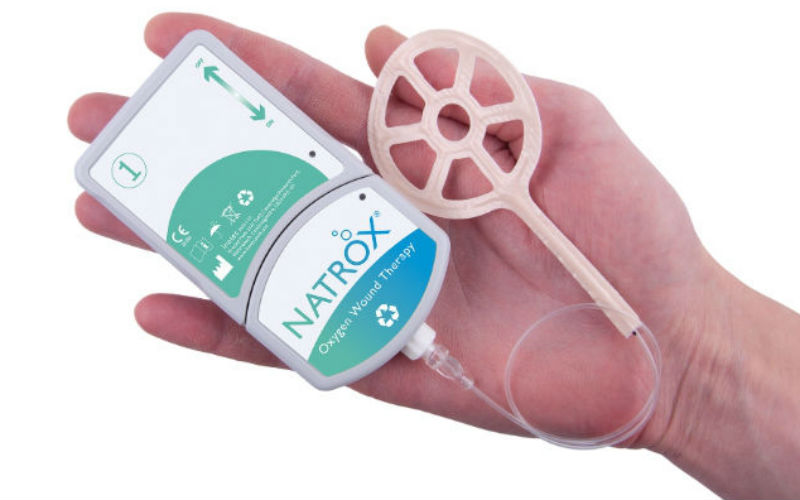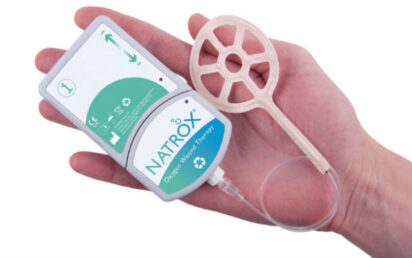A medical device smaller than an iPhone is using pure oxygen to cure the wounds of NHS patients.
The NATROX® O₂ device, developed by Cambridge University spinout Inotec – No.1 on our MedTech 50 ranking last year – is now gaining traction after more than two decades of development.
Its ‘wheel’ design – made from a supple, pliable material – molds effortlessly to wounds to deliver pure oxygen and stimulate healing. Non-invasive and portable, it is suitable for home use as well as in clinical settings.
Led by US medical specialist Craig Kennedy for the last five years, NATROX® O₂ is available via the UK’s NHS Supply Chain and NHS Shared Business Services.
“Holes in the side of the device pull in moisture or air. Through electrolysis, we separate the oxygen and hydrogen molecules and send the oxygen molecules right down to the patient’s wound,” Kennedy explains to BusinessCloud.
“The delivery system is a tube with a wagon wheel that you put right on the wound and deliver pure oxygen right to it.
“The primary wounds that we focus on are diabetic foot ulcers, venous leg ulcers, arterial ulcers and pressure ulcers on patients that are wheelchair bound or bedridden.”
Inotec – NATROX® O₂ device heals wounds with humidified oxygen
Diabetes
The vast majority of patients using the therapy – which has to be prescribed by a medical professional – suffer from underlying conditions such as diabetes, Kennedy says.
“Wound care patients all have comorbidities, and most of these comorbidities affect blood flow or oxygenation of the blood,” he expands. “Even if there’s blood flow to the wound, many times it doesn’t have the right amount of oxygen.
“What that wound’s really missing is oxygen that triggers the energy to heal the wound and fight infection. Oxygen is the basis for living cells. And it’s no different when you’re trying to repair cells.”
It is vital to take into consideration the overall needs of the patient. For example, diabetes often causes peripheral neuropathy, where nerves in the body’s extremities – such as the hands, feet and arms – are damaged.
“This makes diabetic foot ulcers a huge problem because if the patient can’t feel their feet, weeks may pass where they have no idea that they have a wound [on the bottom of them],” says Kennedy (below). “By the time they realise that there is an infected wound, it is difficult to heal.
“Or if you have a mastectomy and do nipple salvage on that patient, a lot of times there’s very little blood flow around that area. So many of those fail. By adding oxygen, you can improve the outcome, which is incredibly important to these poor women that have just gone through this process.”
Global plans
Inotec – backed by investors including Amadeus Capital Partners, Wealth Club and Praetura Ventures across several rounds of funding – recently signed a deal which sees Raise Healthcare become its exclusive distributor in the UK, while a number of key appointments aim to see it expand in the US and globally.
“We’ve made great progress,” says Kennedy. “We’ve got the right team in place and the right product – now it’s about commercialising it and growth. That takes time. Especially when you’ve gone through an 18-month pandemic!”
The CEO, who is based in the US, adds: “When I was brought on in 2018, we had FDA (United States Food and Drug Administration) approval, but we had nothing in the US – I mean zero. No one even knew who we were. We had to go through and make sure that we had the right clinical data, the right marketing; we had to literally start from zero, and we had nobody here working for us.
“It was a lot of work to do. The challenge was to get that study done so we could submit for consideration for reimbursement in the US, because that’s where the money is.”
COVID brought its progress in the NHS and the Vietnam veteran affairs group in the US to a “screeching halt”, says Kennedy. “You couldn’t get into hospitals, talk to doctors, see nurses… and even if you could, their focus was rightfully in other places.
“We took that time to develop an app to do advanced therapy at home. We partnered with a company in the US to develop a version of their product that we could sell as a remote monitoring solution – so that patients who were at risk and scared to come into a clinical setting [due to COVID] could get treated at home.”
MedTech 50 – UK’s most innovative medical technology creators for 2022
Simplicity
Kennedy served as VP of business development at Johnson & Johnson’s advanced wound care business Systagenix from 2008 for four years before it was sold. He then became the first CEO of MolecuLight – a startup which visualised bacteria and measured wounds at the point of care. “We got it from a cool idea, a little bit of money, into something that was a product that we could manufacture and sell, got it registered,” he says.
“After leaving that, I was honestly looking at ways to get out of the wound care space and into something else. But when I got the opportunity with NATROX and InoTec, it was one of the few companies that I would stick around for – because I truly believe in the technology.
“After being in the market for so long you kind of get to know what works and what doesn’t – and this one just ticked all the boxes.”
He concludes: “It’s such a simple product. I think the one thing I’ve learned after being in medical devices over the years is that efficacy is good; but simplicity is more important. If people don’t use it, it’s not going to work.”


